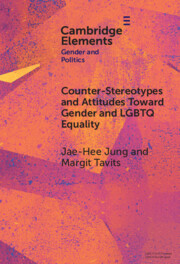Element contents
Counter-Stereotypes and Attitudes Toward Gender and LGBTQ Equality
Published online by Cambridge University Press: 22 March 2024
Summary
- Type
- Element
- Information
- Series: Elements in Gender and PoliticsOnline ISBN: 9781009406628Publisher: Cambridge University PressPrint publication: 11 April 2024



